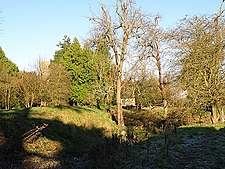| English Bicknor Castle | |
|---|---|
| English Bicknor in Gloucestershire, England | |
 The castle ruins today | |
| Coordinates | 51°50′19″N2°36′31″W / 51.838611°N 2.608611°W |
| Type | Motte and bailey |
| Site information | |
| Condition | Earthworks only remain |
English Bicknor Castle was a castle in the village of English Bicknor in Gloucestershire, England.
Contents
The castle was built in the 11th century as a motte and bailey design, although some suggest a later construction date in the early 12th century. [1] The motte lay at the centre of two concentric outer bailey walls, producing a roughly circular castle approximately 150 yards across. [2] The motte was placed against the south-west corner of the site, where the ground fell away from the castle, giving additional protection from attack. [2] A square stone keep may have been built at a later stage on the motte, and a church was built in the outer bailey. [2] At the start of years of the Anarchy the castle was controlled by the powerful Miles de Gloucester. [3] The castle escaped destruction at the end of the conflict and was still in use at the beginning of the 13th century, when it was owned by William Avenel; its exact date of final ruin is unknown. [4]
